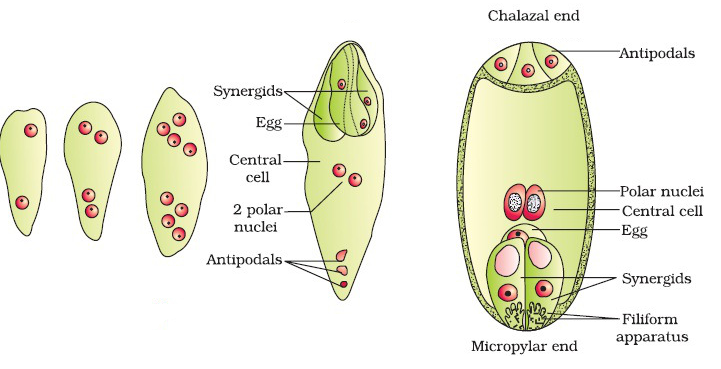
Answer
368.4k+ views
Hint: The term megasporogenesis, in layman’s language can be termed as the process of generation of megaspores.
The 8 nucleate embryo sac development for 80% flowering plants occurs through monosporic embryo sac development type.
Complete answer:
The process of formation of a megaspore mother cell is known as megasporogenesis. The megaspore mother cell or MMC is a large cell containing dense cytoplasm and a prominent nucleus.
The MMC undergoes reductional division or meiosis and forms four haploid megaspores. Out of those four, only one remains functional, and the other three from the micropylar end degenerate.

Now, in the majority of the angiosperms, only one of the four megaspores develops into a female gametophyte and the rest three degenerate. This particular type of development is known as monosporic embryo sac development.
The nucleus of the chalazal functional megaspore (4th megaspore from the micropylar end) divides mitotically into two nuclei which move to opposite poles, forming the 2-nucleate (binucleate) embryo sac.
Again, two subsequent mitotic divisions in these cells result in formation of an 8-nucleate cell. One nucleus from each pole moves into the middle where they form polar nuclei.
Then, at this stage, cytokinesis results in, and the following changes are observed:
Three of the nuclei get organized at the micropylar end and form the egg apparatus (n). One becomes the egg cell (n), and the other two become the synergids (n).
Three nuclei form the antipodal cells (n) at the chalazal end.
Two nuclei in the center are called polar nuclei (n + n).
This ultimately results in a 7-celled and 8-nucleated embryo sac.

Note:
Embryo sac development can be of three basic types based on the number of megaspores that participate in the process:
Monosporic: Only 1 megaspore participates. E.g., Polygonum, Oenothera, etc.
Bisporic: Only 2 megaspores participate. E.g., Allium, Endymion, etc.
Tetrasporic: All the 4 megaspores are involved. E.g., Adoxa, Plumbago, Drusa, etc.
The embryo sac nuclear division is termed as free nuclear division, where karyokinesis is immediately not followed by cytokinesis. After all the nuclei division phases are complete, then only cytokinesis creeps in.
The 8 nucleate embryo sac development for 80% flowering plants occurs through monosporic embryo sac development type.
Complete answer:
The process of formation of a megaspore mother cell is known as megasporogenesis. The megaspore mother cell or MMC is a large cell containing dense cytoplasm and a prominent nucleus.
The MMC undergoes reductional division or meiosis and forms four haploid megaspores. Out of those four, only one remains functional, and the other three from the micropylar end degenerate.

Now, in the majority of the angiosperms, only one of the four megaspores develops into a female gametophyte and the rest three degenerate. This particular type of development is known as monosporic embryo sac development.
The nucleus of the chalazal functional megaspore (4th megaspore from the micropylar end) divides mitotically into two nuclei which move to opposite poles, forming the 2-nucleate (binucleate) embryo sac.
Again, two subsequent mitotic divisions in these cells result in formation of an 8-nucleate cell. One nucleus from each pole moves into the middle where they form polar nuclei.
Then, at this stage, cytokinesis results in, and the following changes are observed:
Three of the nuclei get organized at the micropylar end and form the egg apparatus (n). One becomes the egg cell (n), and the other two become the synergids (n).
Three nuclei form the antipodal cells (n) at the chalazal end.
Two nuclei in the center are called polar nuclei (n + n).
This ultimately results in a 7-celled and 8-nucleated embryo sac.

Note:
Embryo sac development can be of three basic types based on the number of megaspores that participate in the process:
Monosporic: Only 1 megaspore participates. E.g., Polygonum, Oenothera, etc.
Bisporic: Only 2 megaspores participate. E.g., Allium, Endymion, etc.
Tetrasporic: All the 4 megaspores are involved. E.g., Adoxa, Plumbago, Drusa, etc.
The embryo sac nuclear division is termed as free nuclear division, where karyokinesis is immediately not followed by cytokinesis. After all the nuclei division phases are complete, then only cytokinesis creeps in.
Recently Updated Pages
Who among the following was the religious guru of class 7 social science CBSE

what is the correct chronological order of the following class 10 social science CBSE

Which of the following was not the actual cause for class 10 social science CBSE

Which of the following statements is not correct A class 10 social science CBSE

Which of the following leaders was not present in the class 10 social science CBSE

Garampani Sanctuary is located at A Diphu Assam B Gangtok class 10 social science CBSE

Trending doubts
A rainbow has circular shape because A The earth is class 11 physics CBSE

Which are the Top 10 Largest Countries of the World?

Fill the blanks with the suitable prepositions 1 The class 9 english CBSE

How do you graph the function fx 4x class 9 maths CBSE

What is BLO What is the full form of BLO class 8 social science CBSE

The Equation xxx + 2 is Satisfied when x is Equal to Class 10 Maths

Give 10 examples for herbs , shrubs , climbers , creepers

Difference between Prokaryotic cell and Eukaryotic class 11 biology CBSE

Change the following sentences into negative and interrogative class 10 english CBSE




